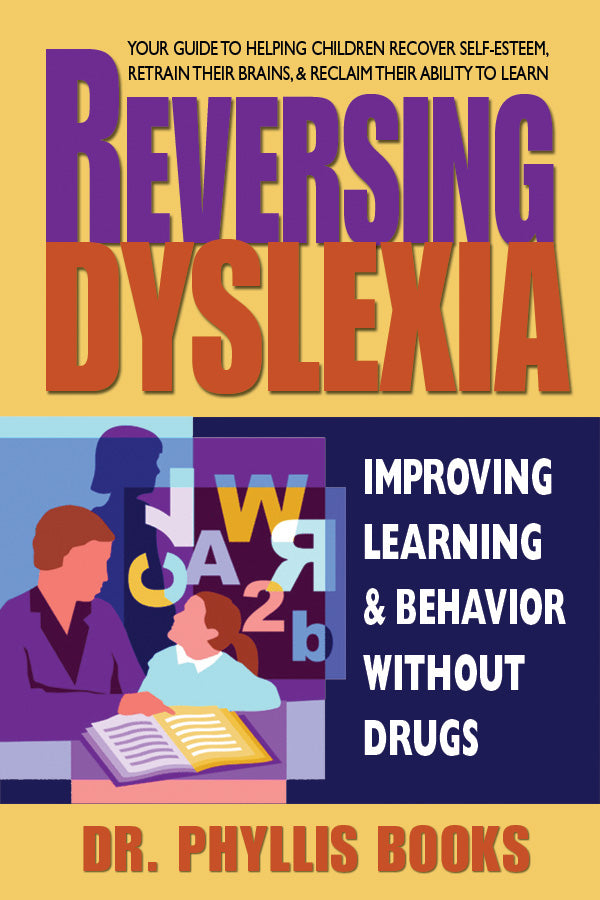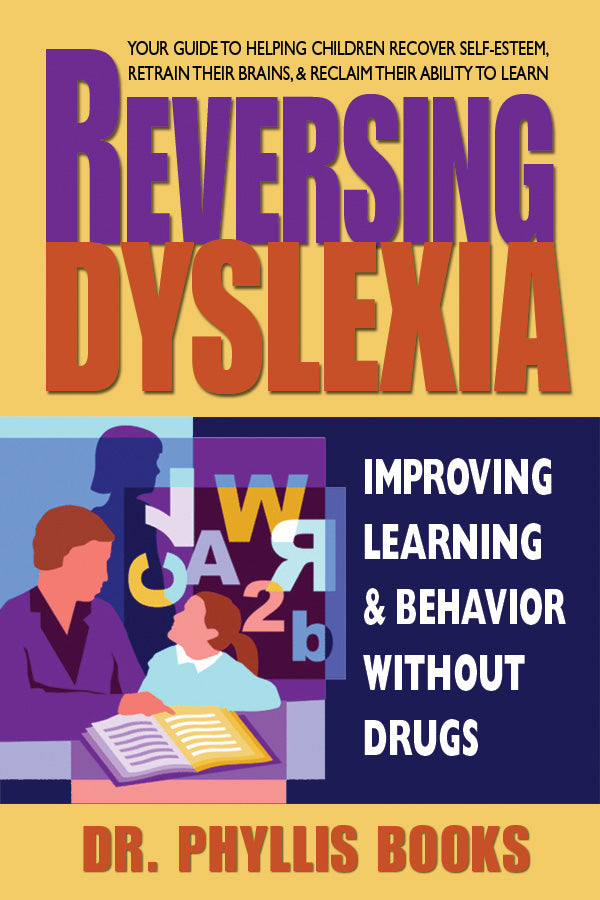Most people do not realize that dyslexia is more than just a reading problem. It is often accompanied by social, psychological, and even physical issues that can make many everyday tasks seem unmanageable. Whether you suffer from dyslexia yourself or are the parent of a dyslexic child, dealing with the overall challenges of this learning disorder can be overwhelming. Unfortunately, mainstream treatment focuses mainly on compensatory techniques and workarounds, not a cure, leaving dyslexics feeling hopeless and stuck. In her new book, Dr. Phyllis Books offers a new approach to dyslexia and a convincing reason to hope again. Drawing upon her vast experience and a wealth of scientific research, she declares that dyslexia can actually be reversed in a large number of cases.
Reversing Dyslexia begins by redefining dyslexia, offering the most comprehensive view of this problem yet. It describes dyslexia’s common symptoms, lists its associated conditions, and details the many theories that surround this issue. It goes on to explain how the brain develops, revealing how an improperly functioning brain may be rewired and repaired through the right combination of therapies, all of which are described in detail. It then shows how important nutrition, exercise, play, and music are to learning ability, and concludes with invaluable advice on how to choose the right school for your dyslexic child.
By providing a modern perspective on dyslexia, this book lays the groundwork for significant improvements not only in reading but also in general learning ability, emotional stability, and psychological well-being. Having worked with thousands of children, parents, and educators, Dr. Books has spent over twenty-five years disproving the idea that dyslexia is a permanent condition. Reversing Dyslexia can teach you how to disprove it as well.
Phyllis B. Books, DC, CCN, holds a BA in education and English from Michigan State University, a master's degree in education and interpersonal communication from the University of North Texas, and a doctorate in chiropractic from Parker University in Dallas, Texas. She is also a Certified Clinical nutritionist. Since 1986, she has specialized in pediatrics and learning differences. Dr. Books is a highly sough-after lecturer and workshop educator, and heads the Books Family Health Center located in Austin, Texas.
Foreword
Introduction
PART I DEFINING THE PROBLEM
1. What Is Dyslexia Exactly?
2. What Causes Dyslexia?
3. Pros and Cons of the Dyslexia Label
PART II NEW PROFESSIONAL SOLUTIONS FOR DYSLEXIA
4. The Neurological Component to Dyslexia
5. New Science and New Hope for Dyslexia
6. What Kinds of Professional Therapies Help Which Kinds of Dyslexia
PART III WHAT YOU CAN DO AT HOME
7. Nutrition and Diet--The Simplified Way
8. Three Brain Boosters: Exercise, Play and Music
9. Schools, Tutors and Extra-Curricular Activities
10. Bringing out the Best in Your Child
Conclusion What’s Next?
Notes
Bibliography
About the Author
Index
When a child has dyslexia, reading troubles and other associated problems can become overwhelming, and the prognosis from the educational and medical world can be discouraging atbest. Popular opinion states that dyslexia is permanent—a problem for which you must learn to compensate—and that you should not believe anyone who says otherwise. Reversing Dyslexia proposes a different view—one that may very well include a happy ending. As the title suggests, dyslexia, in fact, may be reversible.
In addition, when dyslexia is eliminated, many of its accompanying issues, including poor organization, poor time management, and low self-esteem, may be lessened or erased as well. I say all this with confidence because I’ve seen it happen. I’ve watched children who once hated reading devour books after the obstacles of dyslexia were removed. And these success stories are not just about academic improvement. I’ve read notes from soccer and football coaches expressing their amazement at children’s athletic ability after therapy. I’ve received phone calls years after treatment from parents so grateful that their kids didn’t end up in jail, on drugs, or even institutionalized—parents who were close to giving up, who did not know where to turn or what to believe.
Throughout my quarter century as an educator, chiropractor, and nutritionist, I have worked with thousands of children in many countries and instructed healthcare providers on three continents.
I have seen dyslexic children go back to mainstream classes, get college degrees, and achieve fulfilling careers. I know that dyslexia is reversible because I have witnessed this change over and over again. You too may be able to witness it, but not before you embrace a new mindset. You have to believe change is possible. I know you don’t want to get your hopes up. I know you’ve been disappointed so many times. I’m asking you not to give up. This book presents important information on dyslexia in a logical, step-by-step, practical way that will allow you to see for yourself that change is possible.
Because dyslexia is always so narrowly and inappropriately defined, Chapter 1 seeks to clarify this condition by redefining it in broader terms. It explains the various theories of dyslexia and considers the fact that each of these theories may be valid in its own way. It then details the possible causes of dyslexia, from genetic predispositions to environmental reasons. Chapter 2 aims to help you determine whether or not your child is dyslexic. It not only describes the common clues that point to this issue, which include symptoms such as difficulty reading and trouble remembering oral instructions, but also lists associated conditions that parents may overlook as markers of dyslexia, including ADHD, depression, and anxiety. To adjust the established view of dyslexia and change the traditional approach to therapy, Chapter 3 sheds light on the Triune Brain, which divides the brain into three layers.
This idea of a three-tiered system suggests that therapy must begin at the lowest level of the brain and move upwards in order to be truly successful. It also illustrates how important the notions of safety, attachment, physical movement, and creativity are to cognitive development and learning. Chapter 4 calls into question the traditional approaches to therapy, which mostly rely on workarounds and compensatory measures, by explaining the scientific studies of neuroplasticity and epigenetics. These fields consistently show how the brain may be rewired at any age—an idea that holds great significance to the reversal of dyslexia and other learning challenges. It goes on to outline alternative treatments that may help to retrain the brain, and offers information that can effectively guide you in treatment decisions. Chapter 5 describes the huge role nutrition plays in learning and learning disorders, focusing on the four major sources of trouble: wheat, dairy, sugar, and caffeine. It also explains how to change your mindset about food and improve the quality of every meal you have, including snacks.
Building on the idea of layered brain development and the possibility of rewiring the brain, Chapter 6 discusses the three major brain boosters: exercise, music, and play. It gives examples of all sorts of activities you can do at home to promote a fully integrated brain and stimulate the ability to learn easily. Finally, Chapter 7 details the schooling options available at every level and suggests which ones may be the most beneficial to a dyslexic individual. This information will help you make the informed choices necessary to ensure an advantageous learning environment.This chapter also considers the benefits of tutoring and recommends helpful extracurricular activities to pursue th throughout the school year and during summer break.
New science strongly suggests that a family history of dyslexia doesn’t mean you must suffer from this learning disorder as well. Reversing Dyslexia describes how previously controversial approaches to treatment are now being scientifically validated.
The right combination of therapy and at-home practices can make an immense difference in the life of a dyslexic individual. Dyslexia and all its connected problems often feel like more than one person can manage, so I hope that you consider me a partner in your struggle as you read this book. The label of dyslexia is a difficult one to wear, but it does not have to be a permanent mark. The brain can change. Dyslexia is not necessarily destiny.





